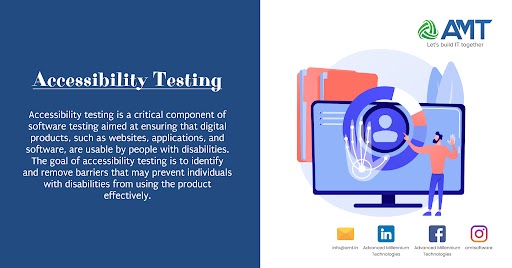Accessibility testing is a critical component of software testing aimed at ensuring that digital products, such as websites, applications, and software, are usable by people with disabilities. The goal of accessibility testing is to identify and remove barriers that may prevent individuals with disabilities from using the product effectively.
Here are some key aspects of accessibility testing:
- Compliance: Testing for compliance with accessibility standards such as the Web Content Accessibility Guidelines (WCAG) is crucial. WCAG provides guidelines for making web content more accessible to people with disabilities. Compliance can involve testing for factors like keyboard accessibility, alternative text for images, captions for multimedia content, and more.
- User Experience: Accessibility testing also focuses on the overall user experience for people with disabilities. This includes testing with assistive technologies such as screen readers, magnifiers, speech recognition software, and alternative input devices to ensure that users can navigate and interact with the product effectively.
- Functional Testing: Functional testing ensures that all features and functionalities of the product are accessible to users with disabilities. This involves testing forms, menus, buttons, links, and other interactive elements to ensure they are operable and understandable for all users.
- Compatibility Testing: Accessibility testing also involves testing for compatibility with different assistive technologies, browsers, and devices. It ensures that the product functions correctly across various platforms and environments that people with disabilities may use.
- Documenting Issues: During accessibility testing, testers document any accessibility issues they encounter, along with recommendations for fixing them. These issues are often categorized based on their severity and impact on users, helping developers prioritize fixes.
- Regression Testing: As with other types of testing, accessibility testing should be performed regularly, especially after making changes to the product. This helps ensure that new features or updates do not introduce accessibility barriers.
- Training and Awareness: It’s essential to educate developers, designers, and other stakeholders about accessibility best practices and the importance of making products accessible to everyone. Training sessions and awareness programs can help teams integrate accessibility into their development processes from the outset.
By conducting thorough accessibility testing, organizations can create digital products that are inclusive and accessible to a broader range of users, ultimately enhancing usability and user satisfaction.
Here are some additional aspects and techniques related to accessibility testing:
- Color Contrast Testing: Ensuring sufficient color contrast between text and background elements is crucial for users with visual impairments. Tools like color contrast checkers help identify color combinations that meet accessibility standards.
- Focus Management: Keyboard navigation is essential for users who cannot use a mouse. Testing ensures that all interactive elements can be easily accessed and activated using keyboard shortcuts and that focus indicators are clearly visible.
- Screen Reader Testing: Screen readers are assistive technologies that read aloud the content of a webpage or application for users with visual impairments. Testing involves using screen readers to navigate through the product and ensuring that the content is presented in a logical order and that important information is conveyed accurately.
- Alternative Text Testing: Images should have descriptive alternative text (alt text) to provide context for users who cannot see them. Testing involves verifying that all images have appropriate alt text and that it accurately describes the content or function of the image.
- Semantic HTML Testing: Using semantic HTML elements correctly improves accessibility and usability. Testing involves ensuring that headings, lists, forms, and other HTML elements are used appropriately to provide structure and meaning to the content.
- Audio and Video Testing: Multimedia content should be accessible to users with hearing impairments through captions or transcripts. Testing involves verifying the availability and accuracy of captions or transcripts for audio and video content.
- Responsive Design Testing: Accessibility testing should include testing on different devices and screen sizes to ensure that the product is usable and accessible across a range of devices, including mobile phones and tablets.
- Aria (Accessible Rich Internet Applications) Testing: ARIA attributes are used to enhance the accessibility of dynamic content and web applications. Testing involves ensuring that ARIA attributes are used correctly and that they provide additional context or functionality to assistive technologies.
- User Testing with People with Disabilities: Conducting usability testing with people with disabilities provides valuable feedback on the accessibility of the product from the perspective of its intended users. Involving users with disabilities throughout the development process helps identify and address accessibility issues early on.
By incorporating these additional techniques into accessibility testing processes, organizations can ensure that their digital products are truly inclusive and accessible to users of all abilities.
Above is a brief about Accessibility Testing. Watch this space for more updates on the latest trends in Technology.
